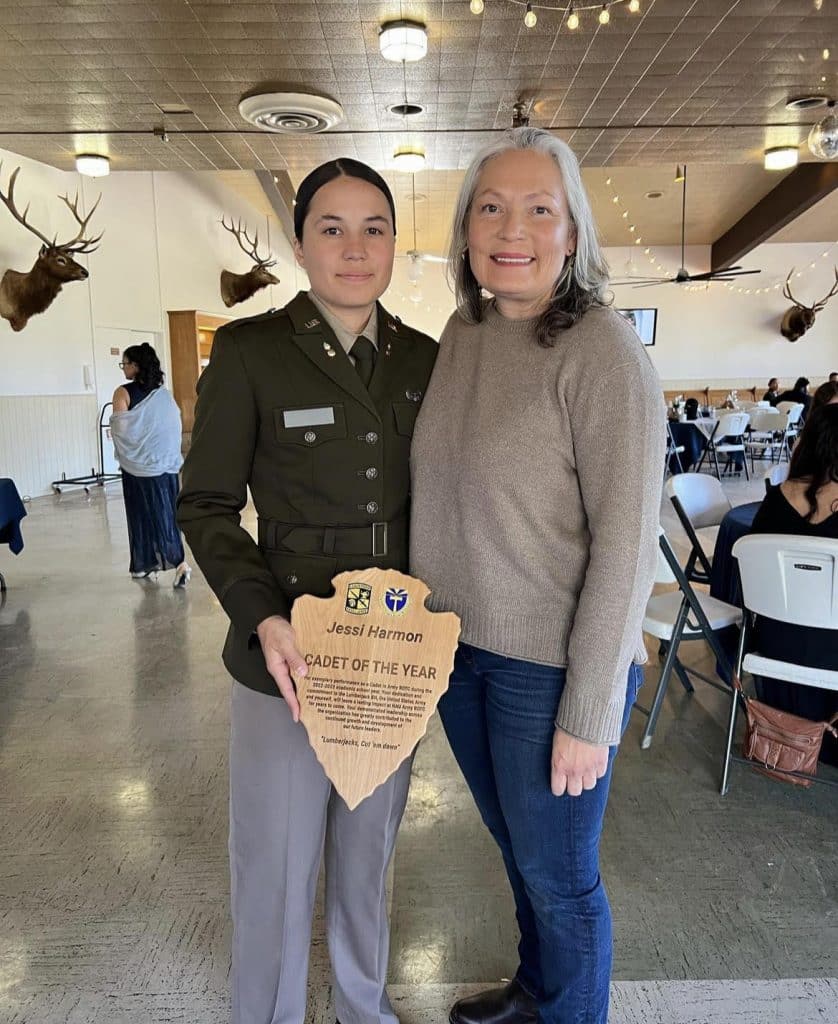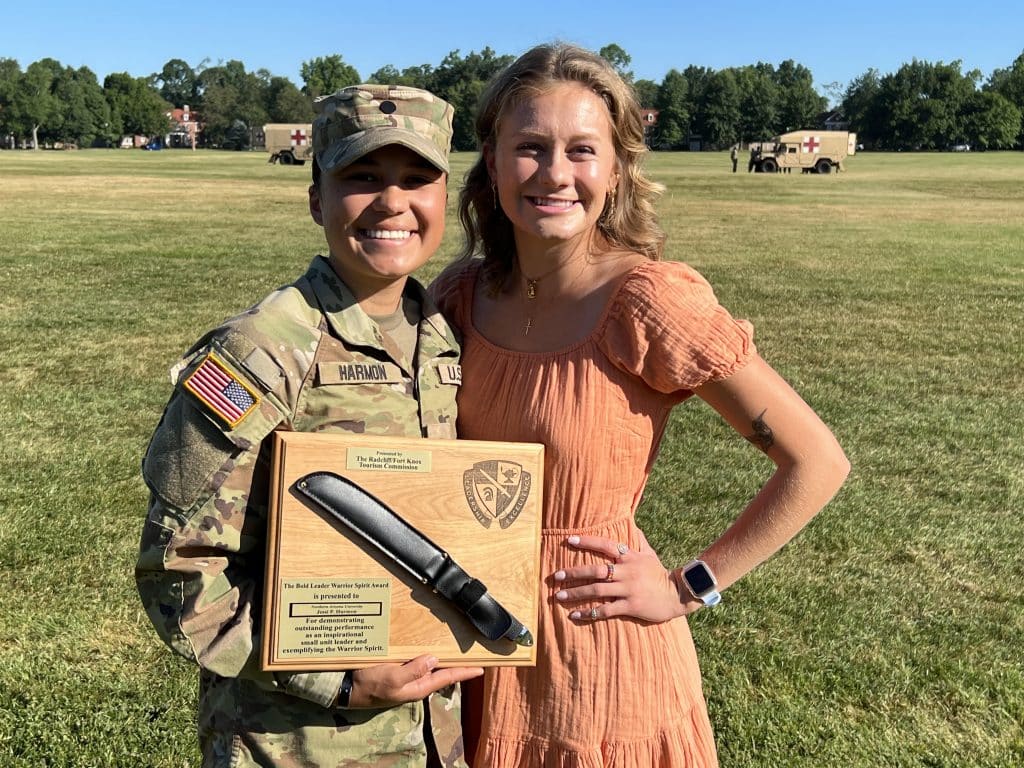Jess Harmon grew up with certain ideas in her mind of what she, as a Native American woman, could do and be.
Somewhere in her college years, instead of trying to outrun that narrative, she decided to throw it away altogether and write her own story. Although the end of that story remains unwritten, this particular chapter—returning to Flagstaff, enrolling at NAU, joining the ROTC—has a happy ending; she graduates this week with a degree in biology, after which she will be commissioned as a second lieutenant in the U.S. Army.
“When I left Flagstaff to attend other universities, I think I was looking for a place to escape that wouldn’t come with any expectations of my outcome and the life I could have,” Harmon said. “After spending time in both Virginia and Hawai’i, I came to realize that negative biases and limiting expectations that society sets for women of color are impossible to escape, but rather than running from them, it is far more impactful to change the narrative and prove to both yourself and the world that you can be successful.”

Harmon’s journey
When it came time to go to college, Harmon decided to leave her hometown. She enrolled in a majority-white institution in Virginia, never felt comfortable and dropped out in her first semester. Then she enrolled in a university in Hawai’i, confident that she would find the role models and inclusive environment that she sought.
Then came March 2020, and the whole world changed. It made the most sense for Harmon to return home to Flagstaff and enroll at NAU. This time, it was like coming home; she found a support system she’d been missing at other universities; she felt safe pushing herself to take on leadership roles, take chances academically and physically; and found women of color, especially Native women, as role models—women who were graduating with degrees in STEM fields and taking on leadership roles throughout campus. She joined ROTC and found teachers who pushed her toward success. And she found success—not without failure, but because at NAU and with her family, ROTC and professors, she felt safe enough to try, fail and keep going.
ROTC played a big role in Harmon’s time at NAU. She knew going in that she wanted to make a positive difference for the greater global community but felt powerless as one person to do much. She needed a team working toward the same goal.

“This led me to the Armed Forces, whose mission set expands beyond warfare and is one of the greatest contributors to humanitarian relief efforts, scientific research, peacekeeping and progress,” she said. “All of those things are greatly appealing and a great way to be of service to more communities than just my own.”
Research into the different job opportunities in the military led her to the realization that officers serve as facilitators and managers—they are the decision-makers, the change-makers in the organization. She chose the field of explosive ordnance disposal (EOD) because it was a small, tight-knit community. In this role, she will lead a platoon of seven to 12 soldiers, which will allow her to build relationships with and support each individual in her command. All of that appeals to her, though so does the other part of the job.
“It also doesn’t hurt that I’ll get to blow things up!”
During her time in ROTC, she was embedded with three different operational detachments of Green Berets, completed the U.S. Army Air Assault School and Cadet Troop Leader Training. Harmon received the Gen. George C. Marshall Award in Ethical Leadership, the Top Senior Cadet Award and the Hero of the Battle Award in both 2021 and 2022, which is given to the cadet who is most influential to the success of the mission at the semester’s field training exercise.
Major Michael Britz, who worked with Harmon throughout her three years in the ROTC, said she was level-headed, mature and had the responsibility and work ethic of a much older leader. All of those skills became clear when Harmon was selected to lead a top-tier special forces unit during a tactical training exercise that was designed to certify that unit to deploy.
“She led this team of seasoned warfighters to assault multiple objectives, during the day and in complete darkness, to infiltrate an enemy perimeter via helicopter, accomplish their assignment mission and successfully return to base without casualties,” Britz said. “The commander of that unit had such great faith and confidence in her abilities that he entrusted his united to her lead while only a cadet. She has already accomplished more as a cadet than most will accomplish in their first four years of service.”

Of course, her NAU experience wasn’t all ROTC. She did a Seamaster with the Global Expeditions Group, earning college credits in nautical science and leadership studies (and her scuba license) while doing research and study on a boat. Harmon helped with flood and fire cleanup last year in Doney Park and was a peer mentor for students from her tribe.
Even though Harmon ended up at the right college for her, that didn’t make college itself easy. She struggled with time management; she joined clubs, played intramural sports, was going to school now with her best friend and fiancé, was in a leadership fraternity and was in a difficult major. For a self-proclaimed perfectionist, balancing all of these needs was challenging; she often was overwhelmed as she struggled to develop the habits and work-life balance she needed, certainly in college but also as a platoon leader in the Army. She sought out advice and tool, but it was a skill she needed to master on her own.
Finding and becoming a role model
At NAU, Harmon finally felt like she had models of what her life could look like. But the role model that was most significant to her was one she’d unknowingly been looking up to all her life.

“My mother is a 1999 graduate of the NAU nursing program, and as I thought about how no lone looked like me and that I was looking for a role model, I realized that no one looks more like me than my mother,” she said. “She entered the world of higher education through community colleges off of the reservation and worked tirelessly to make it into a 4-year university to earn her degree. Today, my mother is a great example of shattering expectations for Native American women, pursuing a master’s degree as a family nurse practitioner.”
Finding a role model was an important first step. Now she’s working to make sure she is creating the path that other women of color can follow. Working both with her tribe and the local ROTC program, she has volunteered with JROTC programs in high schools throughout the state to talk to them about her journey, about the challenges and the victories—she is graduating at the top of her ROTC class with no debt and with a job—and tells girls that they too can shatter the expectations that society has placed on them. If I can do it, her message is, you can too, and there’s a community waiting to help you.
“I am hoping that young Native women in our community can see that you don’t need to run off to some faraway land to defeat the expectations set for you and create a life you can be proud of,” Harmon said. “The only thing I was given prior to starting college was the knowledge that I could do it and knowing that there were ways to achieve what I wanted despite having no head start—the success I’ve found is of my own making, and it is possible.”
Heidi Toth | NAU Communications
(928) 523-8737 | heidi.toth@nau.edu




